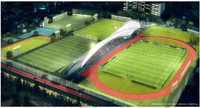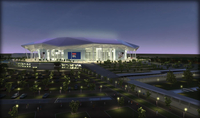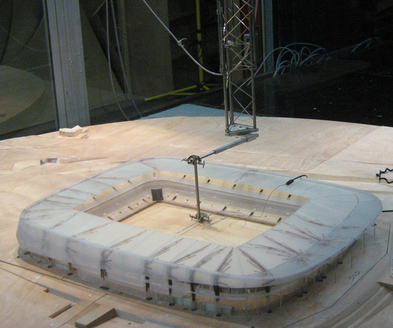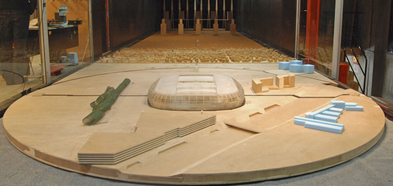New challenges for new stadiums


The concept of "comfort" in stadiums is difficult to study. In this partly open and partly closed hybrid space, the concept of comfort is closely dependent on the architectural morphology of the whole (form, dimension, orientation, etc.) but also to other factors such as the geographic location, sunshine or rainfall. CSTB's work, after being called in by the design office, the architect's office, the town council concerned or private operator (OL), consists of analysing and putting different criteria related to the three domains (aerodynamic, acoustic or lighting) in parallel. This triple approach provides a means of representing the atmosphere and ambiance of the stadium, that make such an important contribution to the spectator's pleasure and therefore the frequency of his attendance! Gérard Grillaud, CSTB engineer, says: "We worked on the future Léo Lagrange stadium in Toulon. It is a long stadium with two grandstands placed offset from each other, and the whole stadium covered by a structure with three arches with a span of 130 meters each. How should the wind design be done, particularly considering the Mistral? What comfort can be expected at the top of the grandstands, particularly in the summer? These are the sorts of questions we were asked." Our work included the construction of a model, tests in the wind tunnel, long discussions on how to analyse the collected measurements: the stadium is now under construction.
Bold architecture = studious approach
The question of wind design and comfort in the grandstands was also important for the Le Mans stadium (particularly due to the astonishing asymmetry of the roof), but other questions needed to be considered. "Our work in the wind tunnel included a study of uniformity on the playing area, says Gérard Grillaud. Obviously, the characteristics of the entire field needed to be the same regardless of where we were in it. And then we considered the question of rain: where would it fall? Would it fall on spectators? And what about rain combined with wind?" Le Mans is not the same as Toulon! In this case, CSTB carried out digital studies in addition to its experimental studies in the wind tunnel …
Another example in Lyon is the future OL Land, Olympique Lyonnais Land (football stadium) designed to hold about 60 000 persons. CSTB acoustics engineers were called in for this project. Firstly to study the acoustic comfort at the outside approach (noise from the very nearby ring road), but also to evaluate the impact of noise generated in the stadium during use (football matches, concerts) and heard by neighbours. Essential work on noise nuisance!


Stadium of the future
Lille stadium is undoubtedly one of the most ambitious projects on which CSTB is currently working. We will have to talk about this stadium conditionally because processing of the building permit is still in the early stages: a stadium that can be fully open or closed: a stadium in which the central field could be separated into two, half of it (6 000 tonnes!) lifting and moving above the other half to reveal a hand-ball court, tennis court or concert hall. CSTB is now working in the wind tunnel particularly on the wind design – based on 11 different configurations – and on spectator comfort.
Le Mans, Toulon, Lille and Lyon: CSTB studies different factors that might interfere with the comfort of spectators at a very early stage. This saves valuable time during the design phase: corrections later on would be very expensive in time and money.


A design assistance guide
The guide designed by CSTB is aimed equally at architects offices and the town councils concerned, and starts by identifying four major families of stadiums – for example stadiums in the "Athletics" family, or in the "Discontinuous Roof" family. The thermal and acoustic impacts, etc. of their architecture on spectator comfort are analysed point by point, for each family. Comfort criteria are then compared (for example roof material, roof inclination, porosity of the façade, etc.). All of this is put into perspective with the direct environment of the stadium (tropical or temperate climate, nature of the ground, location in an industrial or urban area, and its final function (football, athletics, shows).
Architects
Lille stadium: Valode & Pistre Architectes (Paris) and Atelier Pierre Ferret (Bordeaux).
Le Mans stadium: Agence Cardete and Huet & B. Huet
Lyon stadium: BUFFI (Paris) and HOK (London)
Toulon stadium: Archi5, Erik Giudice
